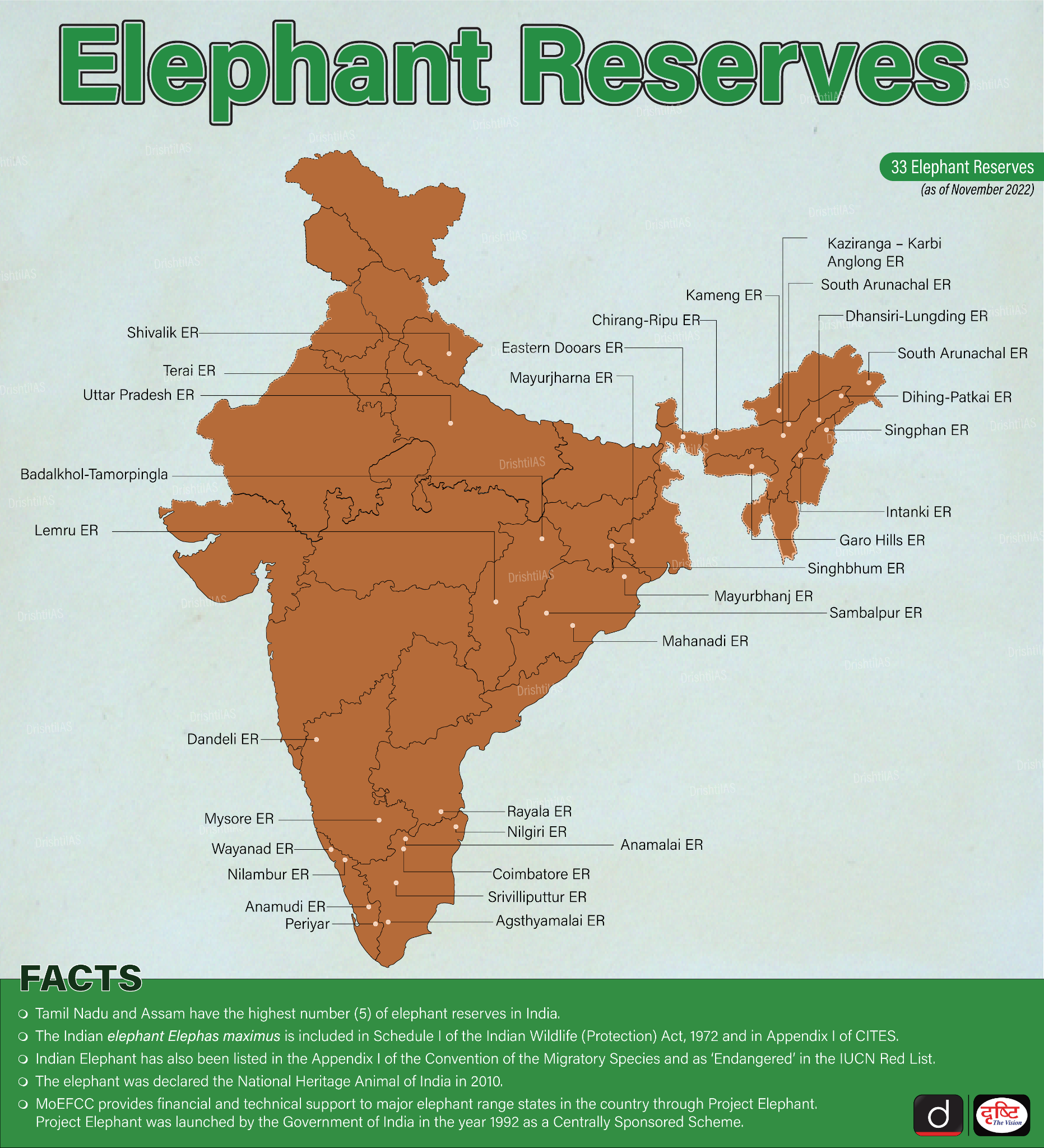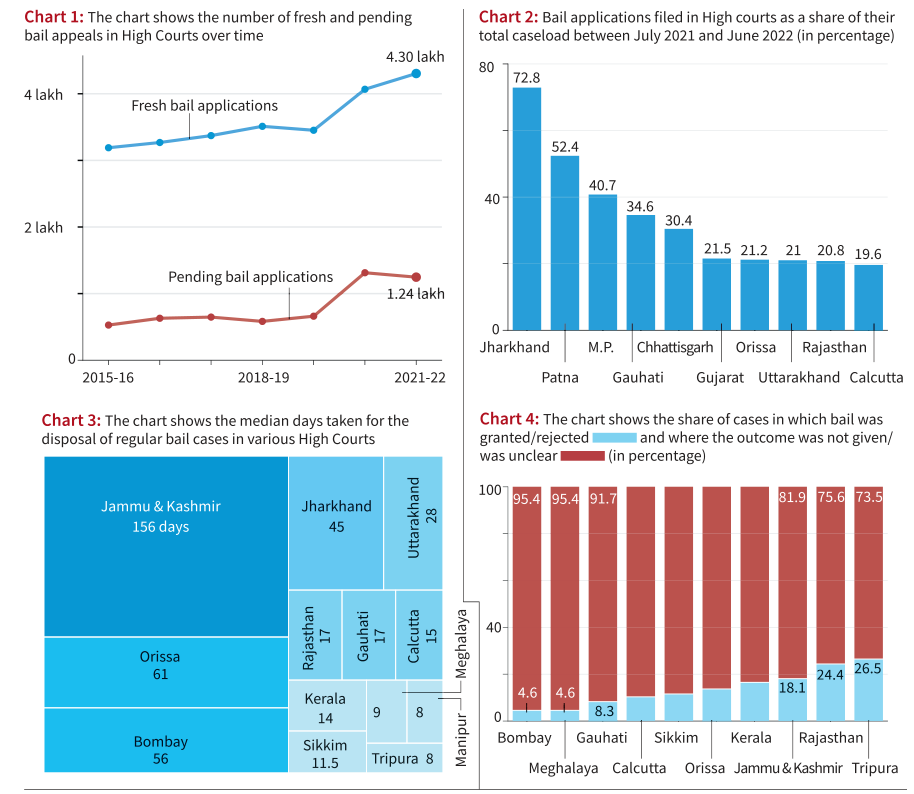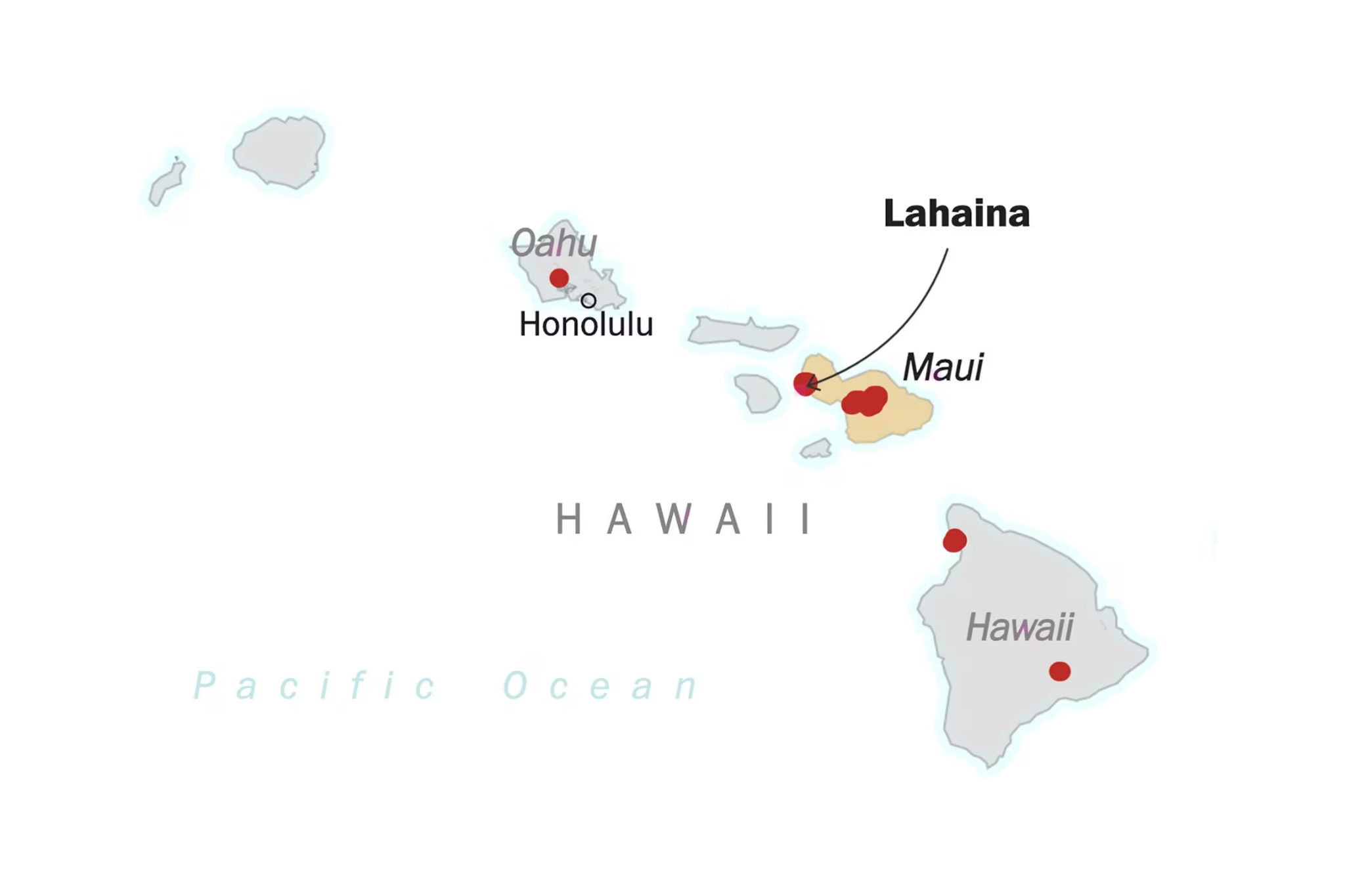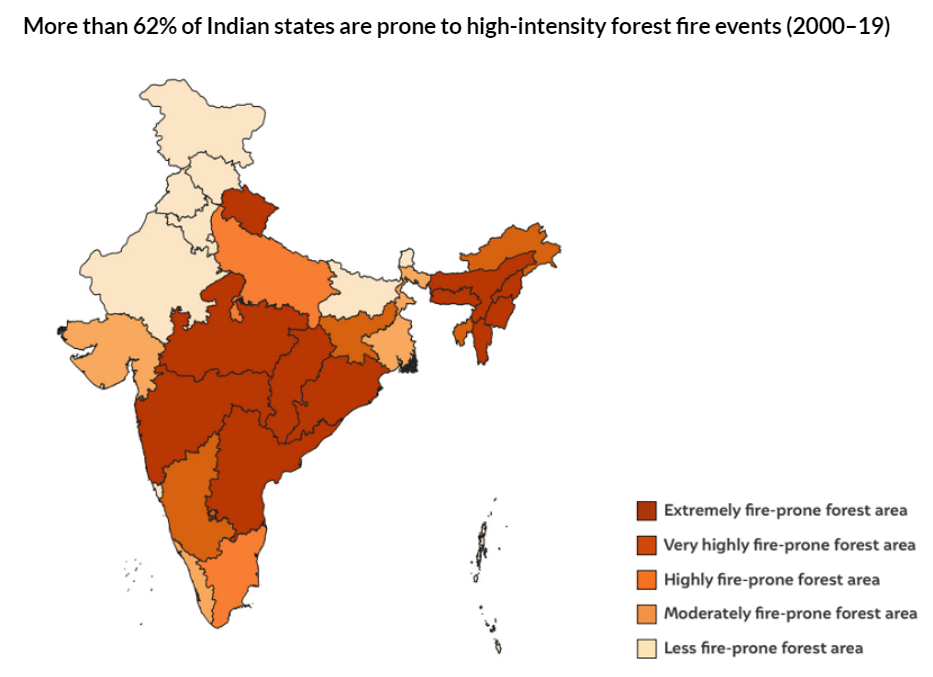Biodiversity & Environment
World Elephant Day 2023
For Prelims: World Elephant Day, Project Elephant, Elephant Reserves
For Mains: Significance of Conserving Elephants and Issues Related to the Elephant Species.
Why in News?
Recently, on the occasion of World Elephant Day, the Union Minister of Environment, Forest and Climate Change and Labour and Employment highlighted various initiatives and accomplishments in India's elephant conservation journey.
What is World Elephant Day?
- About:
- World Elephant Day, observed globally on August 12, is a dedicated observance aimed at raising awareness about the critical challenges confronting elephants and advocating for their protection and conservation.
- This significant day provides a platform to emphasize the issues elephants face, encompassing habitat loss, ivory poaching, human-elephant conflicts, and the imperative for enhanced conservation endeavours.
- Historical Perspective:
- The campaign World Elephant Day was initiated in 2012 to bring awareness to the disturbing situations of African and Asian elephants.
- The objective of this campaign is to create a sustainable environment where animals are not exploited and taken care of.
- It was first observed by Canadian filmmakers Michael Clark and Patricia Sims with the Thailand-based Elephant Reintroduction Foundation.
- In 2012, Patricia Sims founded an organization called the World Elephant Society.
- The organization has succeeded to create awareness about the dangers confronted by elephants and the inevitability to protect them globally.
- In 2012, Patricia Sims founded an organization called the World Elephant Society.
- The campaign World Elephant Day was initiated in 2012 to bring awareness to the disturbing situations of African and Asian elephants.
What are the Key Highlights of Elephants?
- About:
- Elephant is the Natural Heritage Animal of India.
- Elephants are considered a "Keystone Species" as they play a critical role in maintaining the balance and health of forest ecosystems.
- They are known for their exceptional intelligence, boasting the largest brain size of any land animal.
- Significance in Ecosystem:
- Elephants are very important grazers and browsers, eating vast amounts of vegetation every day, spreading seeds around as they go.
- They also help shape the often-thick vegetation of the Asian landscape.
- For example, in forests, elephants create clearings and gaps in the trees that let sunlight in to reach new seedlings, helping plants grow and the forest to regenerate naturally.
- They also help shape the often-thick vegetation of the Asian landscape.
- Elephants will also dig for water when there is not any surface water – opening water access for other creatures as well as themselves.
- Elephants are very important grazers and browsers, eating vast amounts of vegetation every day, spreading seeds around as they go.
- Elephants in India:
- India has the largest number of wild Asian Elephants, estimated at 29,964 according to the 2017 census by Project Elephant.
- It is about 60% of the species’ global population.
- Karnataka has the highest number of elephants, followed by Assam and Kerala.
- India has the largest number of wild Asian Elephants, estimated at 29,964 according to the 2017 census by Project Elephant.
- Conservation Status:
- International Union for Conservation of Nature (IUCN) Red List of threatened species:
- African Forest Elephant (Loxodonta Cyclotis)- Critically Endangered
- African Savanna Elephant (Loxodonta Africana)- Endangered
- Asian Elephant (Elephas maximus)- Endangered
- Convention of the Migratory species (CMS):
- African Forest Elephant: Appendix II
- Asian Elephant: Appendix I
- Wildlife (Protection) Act, 1972: Schedule I
- Convention on International Trade in Endangered Species of Wild Fauna and Flora (CITES):
- African Savanna Elephant: Appendix II
- Asian Elephant: Appendix I
- International Union for Conservation of Nature (IUCN) Red List of threatened species:
What are the Initiatives and Accomplishments in India's Elephant Conservation Journey?
- Addressing Elephant-Human Conflict:
- Establishment of over 40 elephant corridors and 88 wildlife crossings to reduce conflicts.
- Creation of buffer zones around protected areas covering more than 17,000 sq. km.
- Project Elephant:
- Launched in 1992, covering 23 states across India.
- Improved the status of wild elephants, with a population increase from about 25,000 in 1992 to around 30,000 in 2021.
- Elephant Reserves:
- Establishment of 33 Elephant Reserves covering approximately 80,777 Sq.km.
- These reserves play a crucial role in safeguarding wild elephant populations and their habitats.
- Human-Elephant Conflict Management:
- Rapid response teams deployed in various states to handle conflict situations.
- Around 110 critical stretches across the railway network in the country that traverse through elephant habitats have been identified for the implementation of eco-friendly measures to mitigate human-elephant conflicts.
- In these locations measures such as building underpasses, clearing vegetation along the tracks to increase visibility for the loco pilots to avoid collisions, provisioning ramps, and others will also be taken up.
- Community Participation and Empowerment:
- Gaj Yatra program and Gaj Shilpi initiative involving people to raise awareness about elephant conservation.
- Recognition of Exemplary Efforts:
- Conferment of Gaj Gaurav awards individuals and organizations for their exemplary contributions in the field of elephant conservation and management.
- International Agreements and Protocols:
- Participation in international conferences like the Conference of Parties under CITES.
- Monitoring of Illegal Killing of Elephants (MIKE) Programme - The MIKE Programme was established by the CITES by Resolution 10.10 adopted at the tenth Conference of the Parties in 1997.
- The MIKE program started in South Asia in the year 2003 with the following purpose:
- To provide information needed for elephant range States to make appropriate management and enforcement decisions, and to build institutional capacity within the range States for the long-term management of their elephant populations.
- Mike Sites in India:
- Chirang-Ripu Elephant Reserve (Assam)
- Deomali Elephant Reserve ( Arunachal Pradesh )
- Dihing Patkai Elephant Reserve ( Assam )
- Garo Hills Elephant Reserve ( Meghalaya )
- Eastern Dooars Elephant Reserve ( West Bengal )
- Mayurbhanj Elephant Reserve ( Odisha )
- Shivalik Elephant Reserve (Uttarakhand )
- Mysore Elephant Reserve ( Karnataka )
- Nilgiri Elephant Reserve ( Tamil Nadu)
- Wayanad Elephant Reserve ( Kerala)
- The MIKE program started in South Asia in the year 2003 with the following purpose:
UPSC Civil Services Examination Previous Year Question (PYQ)
Q. With reference to Indian elephants, consider the following statements: (2020)
- The leader of an elephant group is a female.
- The maximum gestation period can be 22 months.
- An elephant can normally go on calving till the age of 40 years only.
- Among the States in India, the highest elephant population is in Kerala.
Which of the statements given above is/are correct?
(a) 1 and 2 only
(b) 2 and 4 only
(c) 3 only
(d) 1, 3 and 4 only
Ans: (a)
Exp:
- The elephant herd is led by the oldest and largest female member (known as the matriarch). This herd includes the daughters of the matriarch and their offspring. Hence, statement 1 is correct.
- Elephants have the longest-known gestational (pregnancy) period of all mammals, lasting up to 680 days (22 months). Hence, statement 2 is correct. Females between 14 - 45 years may give birth to calves approximately every four years with the mean interbirth intervals increasing to five years by age 52 and six years by age 60. Hence, statement 3 is not correct.
- As per Elephant Census (2017), Karnataka has the highest number of elephants (6,049), followed by Assam (5,719) and Kerala (3,054). Hence, statement 4 is not correct.
- Therefore, option (a) is the correct answer.


Indian Polity
Surge in Bail Appeals in Indian High Courts
For Prelims: Surge in Bail Appeals in Indian High Courts, High Court dashboard, DAKSH, Epidemic Diseases Act, 1897, Code Of Criminal Procedure (CrPC), 1973.
For Mains: Surge in Bail Appeals in Indian High Courts, Bail Appeals.
Why in News?
The number of Bail Appeals filed in India’s High Courts surged post 2020, according to the ‘High Court dashboard’ by DAKSH, a think-tank focussed on law and justice system reforms.
- DAKSH analyzed 9,27,896 bail cases filed between 2010 and 2021 across 15 High Courts. These courts followed distinct naming patterns for bail cases. The data revealed 81 case types associated with bail across the analyzed High Courts.
What are the Statistics Related to Bail Appeals?
- Bail Appeals are on Rise:
- Bail appeals have risen from approximately 3.2 lakh to 3.5 lakh annually before 2020, to 4 lakh to 4.3 lakh thereafter from July 2021 to June 2022.
- Consequently, the number of pending bail appeals in High Courts has surged from around 50,000 to 65,000 to between 1.25 lakh to 1.3 lakh.
- High Courts and Caseload Distribution:
- The distribution of caseloads varied across different High Courts. In some states, such as Patna, Jharkhand, Odisha, Madhya Pradesh, and Chhattisgarh, bail appeals formed more than 30% of the total caseload between July 2021 and June 2022.
- Disposal Time and Outcome Uncertainty:
- The median time taken for disposal of regular bail applications varied among High Courts. Some High Courts had significantly higher disposal times, raising concerns about delays in the resolution process.
- Delays in deciding on bail cases are seen as equivalent to denying bail, as the accused remains incarcerated during this period.
- Incomplete Outcome Data:
- The data also highlighted the lack of clarity regarding the outcomes of bail appeals in High Courts. In nearly 80% of disposed bail cases in all High Courts, the outcome of the appeal, whether it was granted or rejected, was unclear or missing.
What are the Reasons for Surge in Bail Appeals?
- Covid Violations and Disruption in Court Functioning:
- There has been an increased number of cases related to violations of Covid-19 lockdown norms during the pandemic.
- Additionally, the disruption of court functioning during this period could have contributed to the accumulation of pending bail cases.
- However, the exact cause cannot be definitively determined from court data.
- Epidemic Diseases Act as a Factor:
- The Epidemic Diseases Act, 1897 may have played a role in the increase in bail appeals. While 77% of regular bail cases did not mention the specific Act under which the appellant was imprisoned, analysis of the remaining 23% showed the Epidemic Diseases Act ranked fourth.
- This hints at a potential surge in cases under this Act contributing to the increase in bail appeals.
What is Bail and What are its Types?
- Definition:
- Bail is the conditional/provisional release of a person held under legal custody (in matters which are yet to be pronounced by the Court), by undertaking a promise to appear in the Court as and when required.
- It signifies a security/collateral deposited before the Court for release.
- In Supt. and Remembrancer of Legal Affairs v. Amiya Kumar Roy Choudhry (1973) case, the Calcutta High Court explained the principle behind giving Bail.
- Types of Bail in India:
- Regular Bail: It is a direction given by the Court (any Court within the country) to release a person who is already under arrest and kept in police custody. For such Bail, a person can file an application under Section 437 and 439 of the Code Of Criminal Procedure (CrPC), 1973.
- Interim Bail: Bail granted for a temporary and short period by the Court till the application seeking Anticipatory Bail or Regular Bail is pending before a Court.
- Anticipatory Bail or Pre-arrest Bail: It is a legal provision that allows an accused person to apply for bail before being arrested. In India, pre-arrest bail is granted under section 438 of the CrPc, 1973. It is issued only by the Sessions Court and High Court.
- The provision of pre-arrest bail is discretionary, and the court may grant bail after considering the nature and gravity of the offence, the antecedents of the accused, and other relevant factors.
- The court may also impose certain conditions while granting bail, such as surrendering the passport, refraining from leaving the country, or reporting to the police station regularly.
- Statutory Bail: The remedy of statutory bail, also known as default bail, is distinct from bail obtained in the ordinary procedure under CrPC Sections 437, 438, and 439. As the name implies, statutory bail is given when the police or investigating agency fails to file its report/complaint within a certain time frame.
Note: Article 21 of the Indian Constitution gives everyone the right to life and personal liberty. It provides the fundamental right to live with human dignity and personal freedom, which entitles us to seek bail when detained by any law enforcement entity.


Indian Economy
Floating Rate Loans
For Prelims: Reserve Bank of India (RBI), Equated Monthly Installments (EMIs), Floating Rate Loans
For Mains: Concept of floating rate loans , Challenges in the financial institutions
Why in News?
Recently, the Reserve Bank of India (RBI) will introduce a comprehensive framework to enhance transparency and establish proper rules for resetting Equated Monthly Installments (EMIs) for floating rate loans.
- This move aims to address borrower concerns and ensure fair practices by financial institutions.
What are Floating Rate Loans?
- Floating rate loans are loans that have an interest rate that changes periodically, depending on a benchmark rate or the base rate.
- This base rate, such as the repo rate - rate at which RBI lends money to financial institutions - is influenced by market forces.
- Floating-rate loans are also known as variable or adjustable-rate loans, as they can vary over the term of the loan.
- Floating rate loans are common for credit cards, mortgages, and other consumer loans.
- Floating rate loans are beneficial to borrowers when interest rates are expected to drop in the future.
- In contrast, a fixed interest rate loan requires a borrower to pay set installments during the loan tenure. It offers a greater sense of security and stability in times of fluctuations in the economy.
What is the Need for the New Transparent Framework?
- Until recently, the RBI had been raising the repo rates in order to contain inflation. With a rise in repo rates, the floating rates too increase. This translates into higher EMIs for borrowers.
- But it has been found that instead of asking for higher EMIs, some banks are simply increasing the tenure of the loan without informing the borrower.
- This is making loan repayments unreasonably long and without proper consent from borrowers.
- Prevent borrowers from being harmed by changes in the internal benchmark rate and the spread during the term of the loan.
- Address issues faced by borrowers such as lack of information about foreclosure charges, switching options, and key terms and conditions.
What are the Features of the Framework Proposed by RBI?
- Lenders should communicate clearly with borrowers on resetting the tenor and/or EMI.
- RBI has asked lenders to offer borrowers an option to switch to fixed-rate home loans or foreclosure of loans whenever they want.
- Banks would also need to disclose various charges incidental to the exercise of these options beforehand to borrowers and properly communicate key information to borrowers.
- This would result in borrowers taking a more informed and calculated decision while repaying their home loans.
- Lenders should not engage in unethical or coercive loan recovery practices, such as harassment, intimidation, or violation of privacy.
How will the Framework Benefit Borrowers and Lenders?
- Borrowers will have more clarity, transparency, and choice regarding their floating rate loans, and will be able to exit or switch them without any penalty or hassle.
- Borrowers will be protected from unfair or arbitrary changes in interest rates or EMIs by lenders and will be able to plan their finances better.
- Borrowers will be treated with dignity and respect by lenders, and will not face any harassment or abuse during loan recovery.
- Lenders will be able to maintain good customer relations and trust and avoid reputational risk or legal action due to improper lending conduct.
- Lenders will be able to improve their asset quality and risk management and ensure compliance with regulatory norms and expectations.


Biodiversity & Environment
Large-Scale Wildfires in Hawaii
For Prelims: Large-Scale Wildfires in Hawaii, Wildfires, Volcanoes, Climate Change, Hurricane, El Nino, Council of Energy, National Action Plan on Climate Change.
For Mains: Wildfires, Causes and Impact. Wildfire Mitigation Strategies.
Why in News?
Recently, Hawaii has been grappling with extensive Wildfires that have wreaked havoc across the state.
- The situation has highlighted the significance of hazard mitigation plans and the identification of vulnerable areas, like Lahaina and West Maui communities, where frequent wildfire ignitions and a large number of at-risk buildings were identified in Maui County's plan last updated in 2020.
What caused such a Severe Wildfire in Hawaii?
- Flash Droughts:
- Dry weather combined with strong winds from a passing hurricane played a significant role in fueling the blaze. These conditions, known as "Flash Droughts," involve rapid moisture evaporation from the atmosphere, creating ideal conditions for fire spread.
- Maui is home to one of the six active Volcanoes of Hawaii. Most of Maui was experiencing severe drought, so the dry land, with dry non-native grasses and vegetation, was ready fuel for fires.
- These fed the fires and helped them spread.
- Dry weather combined with strong winds from a passing hurricane played a significant role in fueling the blaze. These conditions, known as "Flash Droughts," involve rapid moisture evaporation from the atmosphere, creating ideal conditions for fire spread.
- Anthropogenic and Climate Change:
- Climate change has increasingly been linked to the rising occurrence of devastating forest fires globally and Hawaii's wildfire outbreak is likely not an exception.
- As temperatures rise and air becomes warmer due to climate change, the conducive conditions for storms and wildfires are amplified.
- Furthermore, the historical land use practices of cultivating irrigated pineapples and sugar cane gave way to invasive, fire-prone grass species as these industries declined.
- This transition has contributed to the vulnerability of the land to rapid fire spread.
- The Winds of Hurricane Dora:
- The fire in Hawaii started in the wild and was carried by the wind that was blowing at almost 100 kmph.
- The winds have their origins in Hurricane Dora, an unusually strong storm in the Pacific Ocean.
- Hundreds of miles away from Hawaii, Hurricane Dora did not hit Hawaii. Instead, the islands were caught between high and low pressure zones due to the hurricane, which resulted in the winds fanning the flames and making these difficult to control.
- The fire in Hawaii started in the wild and was carried by the wind that was blowing at almost 100 kmph.
What are the Key Facts About Hawaii?
- Hawaii sits over 2,000 miles west of California in the Pacific Ocean, comprising a diverse and unique ecosystem.
- It is the 50th and youngest state of the United States.
- Renowned for its stunning natural beauty, Hawaii consists of eight main islands formed by volcanic activity.
- The state's capital is Honolulu.
- With a rich cultural heritage influenced by Polynesian, Asian, and American cultures, Hawaii boasts a vibrant and diverse society.
- The islands offer a variety of landscapes, from lush rainforests to volcanic landscapes, making it a haven for outdoor enthusiasts.
- The archipelago is famous for its hula dance, luaus, and traditional ukulele music. Hawaii's unique flora and fauna include endangered species like the Hawaiian monk seal and green sea turtle.
What are Wildfires?
- About:
- Wildfires, also known as forest fires or bushfires, are uncontrolled fires that rapidly spread across vegetation, including forests, grasslands, shrublands, and other natural landscapes.
- They can be caused by both natural factors, such as lightning strikes, and human activities, including discarded cigarettes, campfires, power lines, and intentional acts.
- Types of Wildfires:
- Crown Fires: They burn trees up their entire length to the top. These are the most intense and dangerous wildland fires.
- Surface Fires: They burn only surface litter and duff. These are the easiest fires to put out and cause the least damage to the forest.
- Ground Fires: Sometimes called underground or subsurface fires occur in deep accumulations of humus, peat and similar dead vegetation that become dry enough to burn.
- These fires move very slowly, but can become difficult to fully put out, or suppress. Occasionally, especially during prolonged drought, such fires can smoulder all winter underground and then emerge at the surface again in spring.
- Causes of Wildfires:
- Human Causes:
- Human acts of carelessness such as leaving campfires unattended and negligent discarding of cigarette butts result in wildfire disasters.
- Accidents, deliberate acts of arson, burning of debris, and fireworks are the other substantial causes of wildfires.
- Natural Causes:
- Lightning: A fairly good number of wildfires are triggered by lightning.
- Volcanic eruption: Hot Magma in the earth’s crust is usually expelled out as lava during a volcanic eruption. The hot lava then flows into nearby fields or lands to start wildfires.
- Temperature: High atmospheric temperatures and dryness offer favorable conditions for a fire to start.
- Climate change: It is causing a gradual but highly significant increasing trend in surface air temperatures, and it leads to record-breaking extremes in many areas when it interacts with the normal periodic warming associated with an El Nino.
- Human Causes:
How Vulnerable is India to the Wildfires?
- The forest fire season normally extends from November to June in India.
- A report by the Council of Energy, Environment and Water (CEEW) has noted:
- A tenfold increase in forest fires over the past two decades and says more than 62% of Indian states are prone to high-intensity forest fires.
- Andhra Pradesh, Odisha, Maharashtra, Madhya Pradesh, Chhattisgarh, Uttarakhand, Telangana, and the Northeastern states are most prone to forest fires.
- Mizoram has seen the highest incidence of forest fires over the last two decades, and 95% of its districts are forest fire hotspots.
- The ISFR (India State of Forest Report) 2021 estimates that more than 36% of the country’s forest cover is prone to frequent forest fires, 6% is ‘very highly’ fire-prone, and almost 4% is ‘extremely’ prone.
- Also, An FSI study has found that nearly 10.66% area under forests in India is ‘extremely’ to ‘very highly’ fire prone.
What are the Government Initiatives to Tackle Wildfirtes?
- National Action Plan for Forest Fires (NAPFF): It was started in 2018 with the goal of reducing forest fires by informing, enabling, and empowering forest fringe communities and incentivizing them to collaborate with state forest departments.
- National Mission for Green India (GIM): Launched under the National Action Plan on Climate Change, the GIM aims to increase forest cover and restore degraded forests.
- It promotes the use of community-based forest management, biodiversity conservation, and sustainable forest practices, which contribute to preventing forest fires.
- Forest Fire Prevention and Management Scheme (FFPM): FFPM is implemented by the FSI under the MoEF&CC. It aims to strengthen the forest fire management system by utilizing advanced technologies such as remote sensing.
- It is the only government-sponsored programme dedicated to assisting states in dealing with forest fires.
What are the Wildfires Mitigation Strategies?
- Create Fire Breaks: Fire breaks are areas where vegetation has been removed, creating a gap that can slow or stop the spread of a fire.
- Monitor and Manage Forests: Monitoring forests and managing them appropriately can help prevent fires from starting or spreading.
- Early Detection and Rapid Response: Early detection of a forest fire is critical for effective mitigation.
- The Forest Survey of India (FSI) is using satellite imaging technology (like MODIS) to analyse forest fire affected areas and boost prevention.
- Fuel Management: Reducing the accumulation of dead trees, dry vegetation, and other combustible materials through activities such as thinning and selective logging.
- Firewise Practices: Safe practices must be adopted in areas near forests viz. factories, coal mines, oil stores, chemical plants and even in household kitchens.
- Practice Controlled Burning: Controlled burning involves setting small fires in a controlled environment.
Conclusion
- The devastating wildfires in Hawaii, particularly on Maui island, are a consequence of a combination of climate-related factors, historical land use changes, and emergency response considerations.
- These fires underscore the broader issue of the increasing frequency and severity of wildfires around the world due to climate change.
- The destruction of culturally significant sites adds another layer of tragedy, as the loss of historical and ancestral connections resonates deeply with the affected communities.


Important Facts For Prelims
Metagenomics
Why in News?
Recently, scientists from the Nigerian Centre for Disease Control conducted a study utilizing metagenomic sequencing for pathogen surveillance.
- The devastation caused by Covid-19 pandemic led to the rapid development of new techniques, like metagenomics, and ignited a paradigm shift in how we identify, monitor, and respond to emerging pathogens.
What is Metagenomics?
- About:
- Metagenomics is the study of microbes in their natural living environment, which involves the complex microbial communities in which they usually exist.
- The study examines the genomic composition of an entire organism, including each of the microbes that exist within it. It facilitates direct sequencing of patient samples, removing the need for prior knowledge of the infectious agent.
- For instance, a single gram of soil consists of 4000 to 5000 different species of microbes, while human intestines consist of 500 different types of bacteria.
- It enables us to understand the diversity, abundance, and interaction of microbes in any system.
- It is different from conventional sequencing methods, which requires culturing or isolating individual species before sequencing their genomes.
- For instance, a single gram of soil consists of 4000 to 5000 different species of microbes, while human intestines consist of 500 different types of bacteria.
- Applications:
- Microbial Community Dynamics: Longitudinal metagenome studies can reveal how microbial communities change in response to environmental perturbations or human interventions.
- Biodiversity Studies: Metagenomics allows researchers to study the diversity of microorganisms in different ecosystems, such as oceans, soil, freshwater, and extreme environments like hot springs.
- Human Microbiome Research: Metagenomics has revolutionized our understanding of the human gut microbiome and its impact on digestion, metabolism, and overall health.
- Bioremediation and Environmental Cleanup: It can identify microorganisms with the ability to degrade pollutants and toxic compounds, which can be harnessed for bioremediation purposes.
- Drug Discovery and Biotechnology: It can uncover novel genes and pathways responsible for the production of bioactive compounds, potentially leading to the discovery of new drugs and therapeutic agents.
- Agriculture and Plant-Microbe Interactions: Understanding the microbial communities in agricultural soils can help optimize nutrient cycling and enhance crop productivity.
What is Genome Sequencing?
- About:
- Genome sequencing is the process of determining the complete DNA sequence of an organism's genome.
- DNA (deoxyribonucleic acid) is composed of a sequence of nucleotides, which are represented by the letters A, T, C, and G, corresponding to the four nucleotide bases: adenine, thymine, cytosine, and guanine.
- Genome sequencing involves identifying the order of these nucleotides along the DNA strands.
Note: The genome is the entire set of genetic material within an organism's cells, and it contains all the information necessary for the growth, development, functioning, and reproduction of that organism.
- Genomic Surveillance and Covid-19 Pandemic: The global response to the Covid-19 pandemic prompted scientists to leverage genome sequencing technologies for surveillance purposes.
- The establishment of platforms like GISAID facilitated the submission and sharing of SARS-CoV-2 genome data, aiding high-throughput genome surveillance activities.
- High-throughput’ refers to sequencing techniques that can parse large quantities of DNA at the same time, including a whole genome at once.
- The establishment of platforms like GISAID facilitated the submission and sharing of SARS-CoV-2 genome data, aiding high-throughput genome surveillance activities.
- Potential: Genome sequencing's potential extended to seasonal viruses like Zika and dengue, as well as diseases like lumpy skin disease in cattle and drug-resistant tuberculosis.
UPSC Civil Services Examination, Previous Year Questions (PYQs)
Q1. With reference to agriculture in India, how can the technique of ‘genome sequencing’, often seen in the news, be used in the immediate future? (2017)
- Genome sequencing can be used to identify genetic markers for disease resistance and drought tolerance in various crop plants.
- This technique helps in reducing the time required to develop new varieties of crop plants.
- It can be used to decipher the host-pathogen relationships in crops.
Select the correct answer using the code given below:
(a) 1 only
(b) 2 and 3 only
(c) 1 and 3 only
(d) 1, 2 and 3
Ans: (d)


Important Facts For Prelims
BOCW SCHEME
Why in News?
Recently, the Minister of Labour and Employment provided valuable insights into the Building and Other Construction Workers (Regulation of Employment and Conditions of Service) Act, 1996 during a written reply in the Rajya Sabha.
What is the Building and Other Construction Workers (Regulation of Employment and Conditions of Service) Act, 1996?
- About:
- The Building and Other Construction Workers (Regulation of Employment and Conditions of Service) Act, 1996, commonly referred to as the BOCW Act, plays a significant role in safeguarding the rights and interests of workers in the construction sector.
- Major Provisions:
- The constitution of State Welfare Boards to administer the welfare fund and to provide various benefits to the registered workers such as accident insurance, medical assistance, education, housing, pension, etc.
- The fixing of hours of work, wages for overtime work, prohibition of employment of certain persons in certain building or other construction work, and the provision of drinking water, latrines, urinals, accommodation, creches, first-aid, canteens, etc.
- The establishment of safety committees and safety officers at every establishment and the framing of rules for the safety and health of building workers.
- It provides for the levy and collection of cess at 1-2% of the cost of construction, as the Central government may notify.
- Eligible Beneficiaries:
- As per the provisions, any worker aged between eighteen and sixty years, engaged in building or construction activities for a minimum of ninety days in the preceding twelve months, is eligible for registration as a beneficiary with the State Welfare Boards.
- Implementation:
- The implementation of welfare schemes for building and construction workers, ranging from life and disability cover to health, maternity support, transit housing, and skill development, is entrusted to the State/UT BOCW Welfare Boards under Section 22 of the Act.
- These welfare measures strive to uplift the livelihoods and well-being of workers who contribute significantly to the construction sector.
- The implementation of welfare schemes for building and construction workers, ranging from life and disability cover to health, maternity support, transit housing, and skill development, is entrusted to the State/UT BOCW Welfare Boards under Section 22 of the Act.
- Recent Developments to Streamline Registration Process: Recognizing the need for simplification and accessibility, the government introduced various measures to ease the registration/enrollment process:
- Unique Identcatioifin Number: The introduction of a Unique Identification Number for registered building and construction workers aims to streamline the identification process and enhance efficiency.
- Local Competent Officers: The delegation or appointment of competent officers at the local, municipal, and panchayat levels contributes to a more decentralized and accessible registration process.
- Self-Certification: The practice of self-certification empowers workers to provide accurate information without requiring physical presence, expediting the registration process.
- Facilitation Centers and Camps: To enhance accessibility, the government established facilitation centers at prominent labor chowks and addas, along with holding regular camps, which provide a convenient means for workers to enroll and update their information.
What are the Other Government Schemes Related to Construction Workers?
- National Initiative for Promotion of Upskilling of Nirman workers (NIPUN)
- Model Welfare Scheme for Building and Other Construction Workers and Action Plan for Strengthening Implementation Machinery
- Pradhan Mantri Shram Yogi Maan-dhan (PM-SYM)


Important Facts For Prelims
Indian Flying Fox Bat: Pteropus giganteus
Why in News?
In a recent study, conducted by scientists from the Centre for Ecological Sciences in the Indian Institute of Science and the Wildlife Institute of India, the nectar and fruit-eating flying fox (Pteropus giganteus), India's largest bat species, has taken on a new dimension of interest.
- Beyond its nocturnal activities, these flying foxes have been found to spend a notable portion of their day-roosting time engaged in environmental vigilance.
What are the Key Highlights of the Study?
- The study unveiled that Pteropus giganteus practices vigilant behaviour during daylight roosting, dedicating about 7% of their resting time to watch for dangers, contrary to their nocturnal nature.
- The study distinguished between social vigilance (observing nearby individuals for conflicts) and environmental vigilance (watching for signs of danger in the surroundings).
- The study observed that vigilance levels varied based on the spatial positioning of the bats within roosting trees, confirming the edge effect hypothesis.
- These bats, acting as a keystone species known for their nectar and fruit-eating habits, contribute significantly to pollination and seed dispersal, thereby playing a vital role in maintaining ecosystem health and biodiversity.
- A keystone species is one that has a disproportionately large effect on its natural environment relative to its abundance, impacting many other organisms in an ecosystem and helping to determine the types and numbers of other species in an ecological community.
- The findings emphasize the urgency of protecting Pteropus giganteus and its habitat to ensure the preservation of its ecological role and the overall balance of the ecosystem.
What are the Key Points About Pteropus giganteus?
- About:
- Pteropus giganteus, commonly known as the Indian flying fox, is a remarkable bat species native to the Indian subcontinent.
- Appearance:
- Pteropus giganteus is characterized by its large size and fox-like facial features.
- Usually displays a dark brown, gray, or black body, often with a distinct yellowish mantle (typical of Pteropus genus).
- Males are generally larger than females.
- Geographic Range:
- Pteropus giganteus occurs in tropical regions of South Central Asia, from Pakistan to China, and as far south as the Maldive Islands.
- Habitat:
- These animals can be found in forests and swamps. Large groups of individuals roost in trees such as banyan, fig, and tamarind. Roosting trees are usually in the vicinity of a body of water..
- Conservation Status:
- Negative Impact:
- Indian flying foxes considered as vermin cause extensive damage to fruit orchards, and are therefore considered pests in many regions. They may also be responsible for spreading disease, particularly the Nipah virus, which causes illness and death in humans.


Rapid Fire
Rapid Fire Current Affairs
A-HELP Programme
Recently, the Union Minister for Animal Husbandry and Dairying inaugurated the 'A-HELP' (Accredited Agent for Health and Extension of Livestock Production) programme.
- A-HELP programme is part of the Azadi Ka Amrit Mahotsav initiative, Pashudhan Jagrati Abhiyaan, and Rashtriya Gokul Mission's goals, fostering livestock enhancement.
- Pashudhan Jagrati Abhiyaan focuses on critical aspects of livestock health, disease management, and animal infertility.
- Rashtriya Gokul Mission focuses on enhancing bovine productivity sustainably using advanced technologies, high genetic merit bulls, and doorstep artificial insemination while promoting the scientific conservation of indigenous cattle and buffalo.
- The 'A-HELP' programme enlists trained women agents for disease control, artificial insemination, animal tagging, and livestock insurance.
- Focuses on critical areas of livestock health, disease management, and animal infertility.
- By empowering women and enhancing livestock, the 'A-HELP' program contributes to the socio-economic progress of rural communities.
Read more: Rashtriya Gokul Mission
NIPCCD Organizes a Training Programme on Poshan Bhi Padhai Bhi
The National Institute of Public Cooperation and Child Development (NIPCCD) conducted a two-day Training Programme on “Poshan Bhi Padhai Bhi” in Madhya Pradesh for State Level Master Trainers.
- The objectives of the program were as follows:
- Promoting early stimulation during the first thousand days and facilitating Early Childhood Care and Education (ECCE) for children aged 3 to 6 years.
- Enhancing the capacities of Anganwadi workers by providing them with a foundational understanding of ECCE curricula and pedagogical approaches. This enables them to deliver high-quality play-based ECCE at the grassroots level.
- Anganwadi is a type of rural child care center in India. It was established as part of the Integrated Child Development Services (ICDS) program.
- To enable Anganwadi Workers to focus on the domains of development (physical and motor, cognitive, socio-emotional-ethical, cultural/artistic), and the development of Foundational Literacy and Numeracy (FLN), as well as related assessments.
- To reinforce Anganwadi workers' understanding of nutrition, including Poshan 2.0 and Saksham Anganwadi, innovations in Poshan, Poshan Tracker, feeding practices, micronutrient deficiencies etc.
Read more: Early Childhood Care and Education
Understanding Muscle Cramps
Muscle cramps, also known as muscle spasms, are sudden and involuntary contractions of one or more muscles. It can occur in any muscle but is most commonly experienced in the legs, especially in the calf muscles.
- It can stem from multiple causes including metabolic imbalances, extreme cold, reduced blood flow, and mineral deficiencies.
- These triggers send sensory impulses to the spinal cord, initiating reflexive muscle contractions that intensify due to a positive feedback loop.
- Massage addresses cramps by employing "reciprocal inhibition," effectively stretching cramped muscles.
- This process aids in overcoming cramps by enhancing blood circulation, which helps eliminate accumulated metabolites causing nerve irritation.
Navroz
The Indian Parsi community is garnering attention as they celebrate Navroz on 16th August, a festivity that heralds the onset of the Persian New Year.
- Navroz, also known as Nowruz or Parsi New Year, is a globally celebrated festival that heralds the arrival of spring and the rejuvenation of nature.
- While Navroz is celebrated globally in March, India showcases a unique tradition due to the Parsis' observance of two calendars. In Maharashtra and Gujarat, states with a substantial Parsi population, vibrant Navroz celebrations take center stage.
- However, the calendar intricacy results in Navroz being celebrated around 200 days later in India, specifically during August.
- In India, Navroz is also known as Jamshed-i-Navroz, after the Persian King, Jamshed.
- Interestingly, India's celebration occurs twice annually: first according to the Iranian calendar, and secondly, according to the Shahenshahi calendar, also followed in Pakistan.
Read more: Navroz












